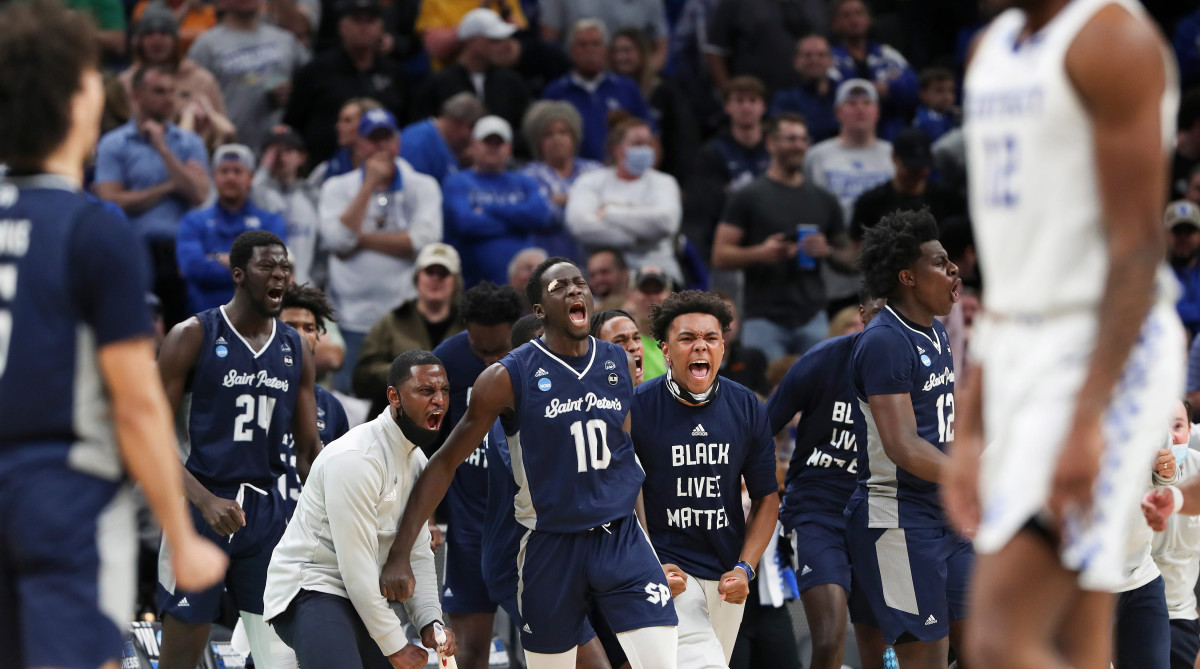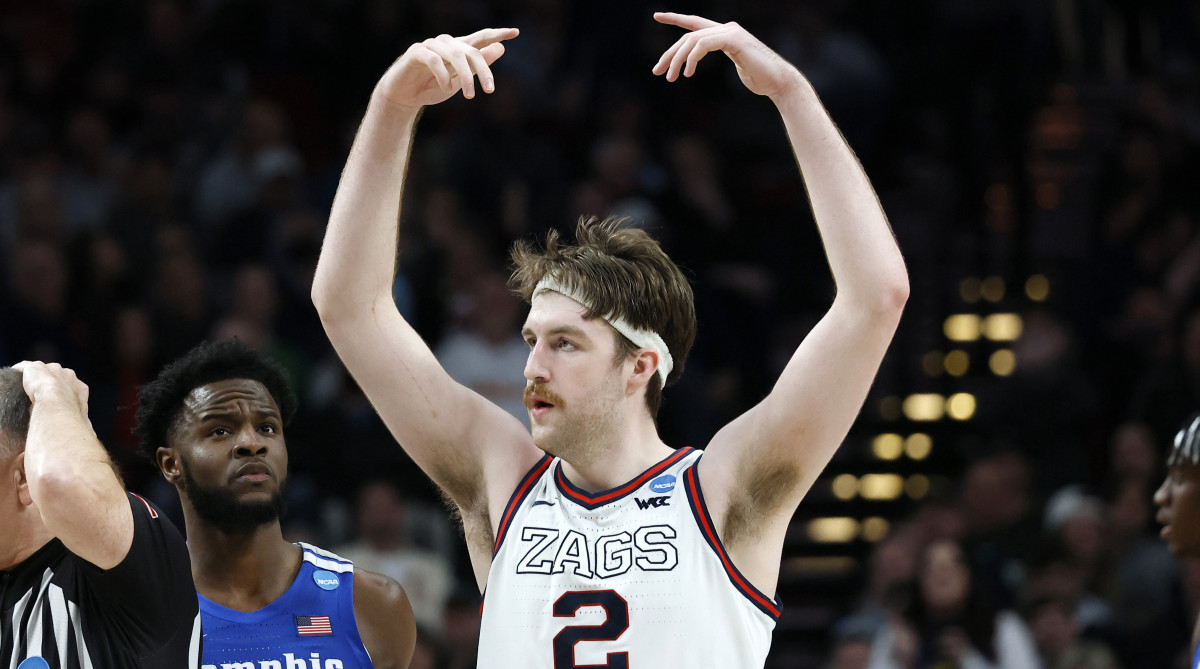The Madness of March Has Led to a Truly Diverse—and Unpredictable—Men’s Sweet 16
When, at 12:37 a.m. EDT Monday, Arizona survived a ridiculous game to close out the second round of the NCAA men’s basketball tournament, complete chaos was narrowly avoided. Had TCU been able to pull off the upset, this tourney would have nearly matched the record for unpredictability—which was set way back in 2021.
The seed total for the remaining 16 teams in the Big Dance is 85. It could have been 93, which would have been surpassed only by the 94 of last year. As it is, the seed total ties for the third-highest in tourney history, along with ’00 and ’18.
Perhaps this is a two-year blip that does not signify anything larger. After all, it was 2019 that produced the chalkiest Sweet 16 since the field expanded to 64 in 1985. But the back-to-back busting of brackets to this extent does raise the question of whether a new level of unpredictability is upon us.
A No. 15 seed has made the Sweet 16 for just the third time, and the ascendance of Saint Peter’s might be the biggest Cinderella to ever get this far. The proud Peacocks are even less likely than Florida Gulf Coast in 2013 and Oral Roberts last year.

Three other double-digit seeds are still dancing—and while No. 11 Michigan, No. 11 Iowa State and No. 10 Miami lack mid-major appeal, they certainly were underdogs to get this far. The Wolverines were a controversial inclusion in the bracket, and neither weather disturbance (Cyclones or Hurricanes) had blown up much of a storm in weeks. Iowa State lost its one and only Big 12 tournament game by 31 points; Miami’s last regular-season victory over an NCAA tournament team was on Jan. 26.
No. 8 North Carolina is as blueblood as it gets. But the Tar Heels were not assured of an NCAA bid until the final game of the regular season. Now they own the distinction of being the first team this tourney to knock off a No. 1 seed, beating Baylor in a game that was thrilling and infuriating.
But that hardly means the other three No. 1s have cruised into the second weekend. Arizona was life-and-death to beat the Horned Frogs in overtime, assisted by a controversial no-call on TCU’s final possession of regulation. (So many controversial calls and no-calls in the early rounds, but that’s another column for another time.) Gonzaga beat Memphis by four after trailing for about 15 consecutive minutes in the middle stages of the game. Kansas led Creighton by a single point inside the final minute before winning by seven.
Thus, we have the first tournament since the expansion to 64 teams in 1985 in which there wasn’t at least one No. 1 seed winning its second-round game by double digits.
As for the No. 2 seeds? Well, they had their own trauma to deal with. Kentucky was defrocked by the Peacocks, as John Calipari has now presided over the worst season in school history (9–16) and the worst NCAA tournament loss in school history in consecutive years. Auburn wasn’t just beaten by No. 10 Miami, it was embarrassed. And for a while Sunday it looked like Mike Krzyzewski’s final game was going to be against No. 7 Michigan State before the Blue Devils edged away in the final minute.
No. 3 Tennessee seized up in the final seven minutes against Michigan. Fellow No. 3 Wisconsin scored all of 49 points in losing to Iowa State. Texas Tech trailed No. 11 Notre Dame with two minutes left before a late 10–0 run got the Red Raiders into the third round.
Among No. 4 seeds, UCLA, Illinois, Arkansas and Providence won their first-round games over Akron, Chattanooga, Vermont and South Dakota State by an average of 4.5 points. Beware the mid-majors who won 20-plus regular-season games; they will not go quietly in March.
As suspected heading into this tourney, there is no dramatic separation of the best from the rest. And the rest know it.
As last year and this year reinforce, the competitiveness and diversity of college basketball are its greatest advantages over college football. Nine conferences are represented in the Sweet 16, and no league has more than three teams (that would be the ACC, which everyone said stunk this year, and the Big 12, which everyone said was great). The West Coast Conference is here for the seventh straight season thanks solely to Gonzaga. The Metro Atlantic has made its first Sweet 16 since being founded in 1980, thanks to Saint Peter’s.
Meanwhile, the football kingpins are struggling. The SEC may tower over the gridiron, but in this tourney, it has been reduced to rubble—five of its six teams are gone, despite having a full slate of favorable seedings. The Big Ten is the other twin tower of football, but that league now has just a pair of programs still dancing in Purdue and Michigan. The winners of the regular-season titles in both conferences (Auburn and Wisconsin/Illinois) are gone. The winners of those league tournaments (Tennessee and Iowa) are gone as well.
The diversity extends to the coaches: Seven of the remaining 16 have been to the Final Four previously, and three have won titles (Krzyzewski, Jay Wright, Bill Self). Gonzaga’s Mark Few, Houston’s Kelvin Sampson and UCLA’s Mick Cronin are all trying to make a repeat Final Four appearance. Miami’s Jim Larrañaga is seeking a second some 16 years after his first.
Nine coaches are trying to get there for the first time. That includes three who freshly moved out of assistant coach roles (Hubert Davis of North Carolina, Tommy Lloyd of Arizona and Mark Adams of Texas Tech), and another guy in his first season at a new school (T.J. Otzelberger of Iowa State). It also includes Matt Painter, in his 14th NCAA tournament and his 17th season at Purdue.

There also is diversity of style, with a notable tilt toward offensive proficiency over defense. Eleven of the 16 teams rank higher in Ken Pomeroy’s metrics on offense than on defense, and five of those are in the national top 10 (Gonzaga, Purdue, Duke, Arizona and Kansas). But there still are some vicious defensive teams in the field, starting with Texas Tech (No. 1 according to Ken Pomeroy) and Iowa State.
In terms of tempo, you have the Few Family Tree that loves to push the pace (Arizona and Gonzaga are Nos. 5 and 6 nationally in tempo). You also have Villanova and Houston ranking among the slowest 25 teams in the nation.
Even the remaining mascots are a diverse bunch. There are four in human form (Boilermakers, Friars, Blue Devils, Red Raiders); two birds (Peacocks, Jayhawks); the previously mentioned two weather disturbances (Cyclones, Hurricanes); three felines (Cougars and the Wildcats of Arizona and Villanova); two of the cloven hoof variety (Razorbacks, UNC’s ram); a couple of other random dangerous mammals (Bruins, Wolverines); and a family pet (Bulldogs).
Who has the clearest path to a Final Four? That would be Purdue, which might finally see years of bad March luck tilt the other direction. The Boilermakers take on Saint Peter’s Friday, and if victorious—a No. 15 seed has never made a regional final—would play either No. 4 UCLA or No. 8 North Carolina. For a program that hasn’t been to the Final Four since 1980, the opportunity is golden.
The hardest path? That remains Gonzaga, which was supposed to get the best draw as the overall No. 1 seed. The West Region is the only one in which the top four seeds have all survived, and the matchups are particularly challenging for the Zags: a super-athletic Arkansas on Thursday, and then potentially either the defensive brass knuckles of Texas Tech or the specter of Krzyzewski, who has been to more Final Fours than anyone in the history of the sport.
Who can actually win two more games—and, ultimately, four more? The guess here is that almost everyone still playing has a chance, give or take Saint Peter’s and Iowa State (that offense, ugh). The flattening of the game, the travails of the top seeds and the full-bracket proliferation of upsets last year and this year suggests that almost all things are possible the rest of the way. Buckle up.
More College Basketball Coverage:
• The ACC Showed Up to Dance
• The ‘Drew Timme Effect’ Kicks in at Just the Right Time for Gonzaga
• Michigan Finds Consistency Just in Time to Halt Red-Hot Tennessee
• Creighton Stifles Caitlin Clark, Iowa to Seal ‘Storybook’ Win Over the Hawkeyes
